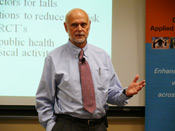McCristal Lecture Focuses on Aging

The bad news is that not only can inactivity adversely affect your health, but also
"sitting time" may add its own layer of problems. The good news is that engaging in
less than the recommended amounts of physical activity may still have benefits.
So reported 2011 James King McCristal Scholar Dr. David Buchner at the Fall College
Meeting of AHS. He has long been investigating the effects of inactivity in older
adults, focusing particularly on the way physical activity relates to falls. As an
investigator in such efforts as the Frailty and Injuries: Cooperative Studies of
Intervention Techniques (FICSIT), the community-based EnhanceFitness program, and
the Otago Exercise Programme (based at the University of Otago in New Zealand), he
and his colleagues found that engaging older adults in balance exercises, strength
training, walking, tai chi, and endurance and flexibility training had a tremendous
impact on the incidence of falls. In one study, exercise groups of adults age 60 and
above experienced about 50 percent of the falls experienced by control groups over a
two-year period. Another study of women age 80 and above demonstrated that balance
training and walking reduced their fall risk by almost 40 percent.
In a study of people with Alzheimer's disease, Dr. Buchner found that engaging
them in physical activity 60 minutes a week improved their physical function, reduced
depression, and resulted in fewer institutionalizations.
In reviewing not only his own research but also that of other scholars, Dr. Buchner
found that few intervention studies in older adults actually prescribe enough activity
to meet guidelines: either 150+ minutes of moderate-intensity activity or 75+ minutes
of vigorous-intensity activity per week recommended by the U.S. Department of Health
and Human Services and the World Health Organization. "Most studies involved
insufficient activity," he said, "yet they all generally showed some benefits,
including the reduction of fall risk and the improvement of functional health."
The latest trend is to measure physical activity using accelerometers to track
distance and speed. The problem, Dr. Buchner said, is that there is not yet consensus
on the "cut points" used to analyze the data from accelerometers. In other words,
how many accelerometer counts correspond to low, moderate, and vigorous physical
activity? He is co-principal investigator in a multi-million dollar study of objective
physical activity and cardiovascular health in women age 80 and above that will in
part be a calibration study to determine appropriate accelerometer thresholds for
this group
By the way, on that "sitting time"? Recent studies report high amounts of sitting
time increase risk of premature mortality, no matter how much moderate-to-vigorous
activity a person does. So get up and move for a longer and healthier life.